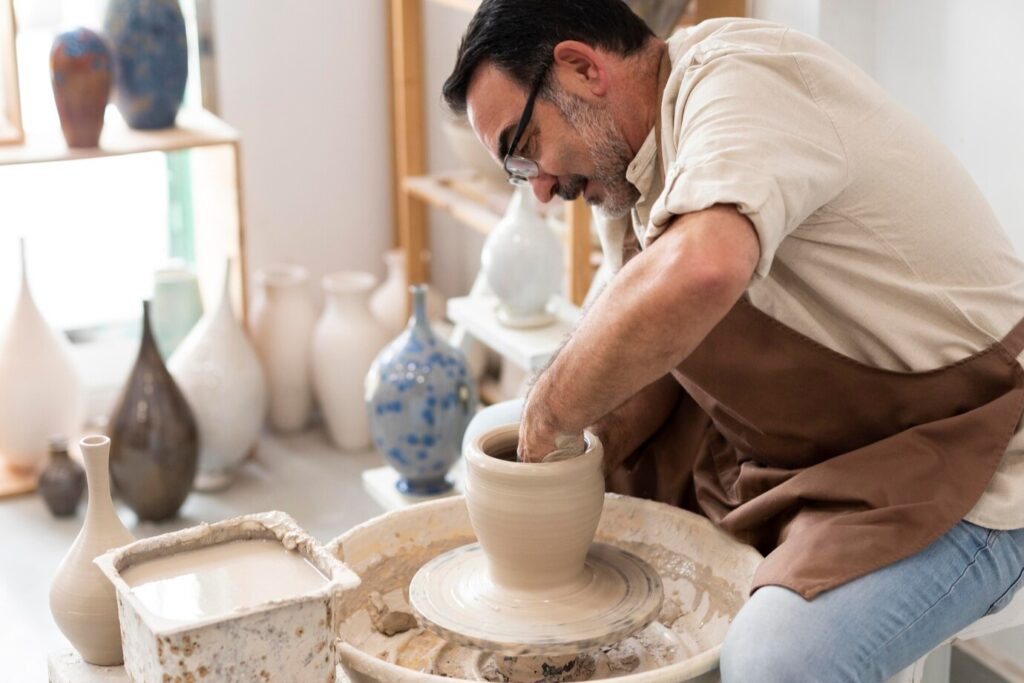Moroccan pottery is more than just functional kitchenware, it is a vibrant expression of culture, craftsmanship, and artistry. From the bustling souks of Marrakech to the serene villages of Fes, Moroccan artisans have perfected their craft over centuries, blending tradition with contemporary design. Today, Moroccan pottery is not only a staple in local households but also a global trend in interior design, offering unique ways to brighten and personalize your living space.
A Legacy of Moroccan Pottery Craftsmanship
Moroccan pottery carries a rich history that reflects the country’s diverse cultural influences, including Berber, Arab, and Andalusian styles. Each piece is carefully handcrafted, often using local clay and natural pigments.
The intricate geometric patterns, bold colors, and detailed motifs are not just decorative—they tell a story of Moroccan heritage. Investing in hand-painted Moroccan pottery means inviting a piece of history into your home while celebrating centuries of artisanal excellence.
Vibrant Moroccan Pottery Colors to Brighten Any Room
One of the standout features of Moroccan pottery is its vivid color palette. Shades of turquoise, cobalt blue, emerald green, and rich terracotta can instantly transform a dull corner into a visual centerpiece.
Whether it’s a large decorative vase for your living room or a set of colorful tagine dishes in your kitchen, these pieces bring warmth, energy, and personality to any interior. Pairing Moroccan ceramics with neutral furniture is a great way to highlight the vibrant designs without overwhelming your space.
.
Versatile Pottery Designs for Modern Moroccan Homes
Moroccan pottery is incredibly versatile. From minimalist bowls to elaborate lantern-shaped vases, there is a design to suit every aesthetic. Modern interior designers often incorporate Moroccan ceramics to create a statement in both contemporary and traditional settings.
Small pieces like hand-painted cups or decorative plates can accent bookshelves or side tables, while larger items such as ceramic planters or bold vases add an artistic flair to living rooms, patios, or entryways.
Hiking Trails in the Middle Atlas Mountains
The Middle Atlas Mountains are often overshadowed by the High Atlas or the Rif, yet they hold some of Morocco’s...
From Passion to Profession: Turning Creative Skills into Income
In Morocco, more young people are transforming their creative talents into careers. Whether it’s photography, calligraphy, fashion design, or digital...
Young Moroccans Abroad: Balancing Wanderlust and Roots
For many young Moroccans, the dream of exploring the world is irresistible. Whether through study, work, or travel, living abroad...
Networking for Millennials: How to Build Real Connections in Casablanca and Rabat
In Morocco’s fast-paced urban centers, especially Casablanca and Rabat, networking is essential for millennials seeking growth and opportunities. No longer...
Sustainability and Supporting Local Moroccan Artisans
Choosing Moroccan pottery is also a sustainable choice. Most artisans use locally sourced clay and natural dyes, relying on time-honored techniques rather than mass production.
Supporting these artisans helps preserve traditional skills and strengthens local economies in regions like Safi, known as the pottery capital of Morocco. By incorporating Moroccan pottery into your home, you contribute to the survival of these artisanal communities and promote eco-friendly décor practices that value craftsmanship over mass production.

Testimonial: Bringing Morocco Home
Ahmed Laghrissi, a master potter from Safi, shares his experience:
“Pottery is not just a profession: it is a way of being, a language passed down through the hands.”
Laghrissi’s words remind us that owning Moroccan pottery is not only about beauty—it is also about carrying with it the soul of Morocco. Every handcrafted vase, bowl, or tagine is a testament to centuries of tradition, making your home feel more connected to authentic Moroccan culture.
Styling Tips: How to Use Moroccan Pottery in Your Home
To make the most of Moroccan pottery in your home, consider these styling ideas:
Mix and Match: Combine different patterns and sizes for a layered, eclectic look.
Highlight a Focal Point: Use a large, colorful vase on a console table, mantel, or dining table.
Functional Art: Utilize tagines, bowls, or plates for daily use—they are both decorative and practical.
Complementary Textures: Pair Moroccan ceramics with textiles like Berber rugs, cushions, or woven baskets for a cohesive, cozy feel.
Conclusion
Moroccan pottery is a timeless way to infuse your home with color, culture, and character. Whether you are drawn to the vibrant hues, the intricate patterns, or the story behind each handmade piece, incorporating Moroccan ceramics elevates your interior décor in both style and substance.
By choosing these handcrafted treasures, you not only enhance your living space but also support Moroccan artisans and preserve a rich cultural heritage. Next time you visit a Moroccan souk or artisan boutique, bring home a piece of pottery. It won’t just decorate your house—it will carry with it the warmth, tradition, and artistry of Morocco.
















Discussion about this post